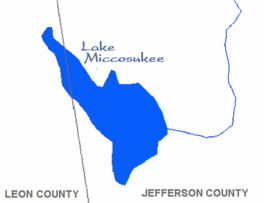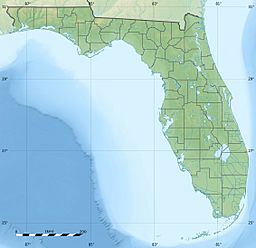Lake Miccosukee facts for kids
Quick facts for kids Lake Miccosukee |
|
|---|---|

Lake Miccosukee, Florida
|
|
| Location | Jefferson / Leon counties, Florida, United States |
| Coordinates | 30°34′15″N 83°58′45″W / 30.5707°N 83.9791°W |
| Type | prairie lake |
| Basin countries | United States |
Lake Miccosukee is a large, swampy prairie lake in northern Florida. It is mostly in Jefferson County, east of the town of Miccosukee. A small part of the lake, its northwest corner, is in Leon County. The town of Miccosukee is located on the lake's northeastern shore.
The lake gets its name from the Miccosukee Native American people.
Contents
About Lake Miccosukee
Lake Miccosukee forms the northern border between Jefferson and Leon Counties. The lake is special because its water level is controlled by a natural opening called a sinkhole at its northern end. This sinkhole connects the lake directly to a huge underground water source called the Floridan Aquifer. This means the lake's surface is actually the top of this large underground water system.
History of Lake Miccosukee
Early History of the Lake
Lake Miccosukee was naturally a "prairie lake." This means its water levels would change a lot, sometimes even drying out completely. Thousands of years ago, the lake was directly connected to the St. Marks River to the south. Today, this connection is underground and reappears in Wakulla County.
The lake's shores were attractive to ancient people, including Paleoindians and later the Apalachee tribe. From the 1830s to the 1860s, the land around the lake was home to a few large cotton plantations.
Changes Over Time
Over the years, descriptions of Lake Miccosukee have changed, especially regarding how much of its surface was covered by water plants. Like other lakes in the area, it was a prairie lake. In 1876, people said the lake was full of plants like maidencane and white bonnets.
By 1914, there was more open water, with the lake being 2 to 5 feet deep. The southern part still had grass and button bushes sticking out of the water. However, by 1976 and 1988, aerial photos showed the lake was again very clogged with plants. Only about 19% of the lake was open water.
In the late 1940s, the amount of plants in the lake changed because the lake would naturally empty and refill about every 10 years. This is normal for prairie lakes in northern Florida. As plants grew back, they would cover more and more of the lake.
Lake Management and Restoration
In 1954, a dirt wall, a concrete spillway, and a gate were built around the sinkhole. This was done to stop the lake from drying out naturally, as it used to do. Also, a wooden barrier called a weir was built at the southern end to keep water from disappearing into another sinkhole.
Between 1954 and 1988, the lake's water level stayed more stable. This meant the lake only dried out twice. However, keeping the water level stable can make a lake "age" faster. This happens because too many plants, dirt, and decaying plant material (called muck) build up. By the late 1990s, the lake was almost completely covered with plants. It became more like a marsh, which is good for alligators and waterfowl (like ducks), but not as good for sport fishing.
In 1999, northern Florida had a drought. This allowed part of Lake Miccosukee to drain into the underground aquifer. During this time, parts of the lake bottom were dug out, and most of the muck was burned away. This "restoration" helps create a healthier home for fish and other wildlife. More restoration could have made deeper areas in the lake. However, permits could not be obtained to allow more burning because of concerns about smoke causing traffic accidents on nearby U.S. Highway 90.
Recreation and Wildlife
Lake Miccosukee is a popular spot for duck hunting in north Florida. It also has beautiful scenery.
A very rare plant, the Miccosukee gooseberry (Ribes echinellum), grows in only three places in the world. Two of these places are on the shores of Lake Miccosukee.
See also
 In Spanish: Lago Miccosukee para niños
In Spanish: Lago Miccosukee para niños



